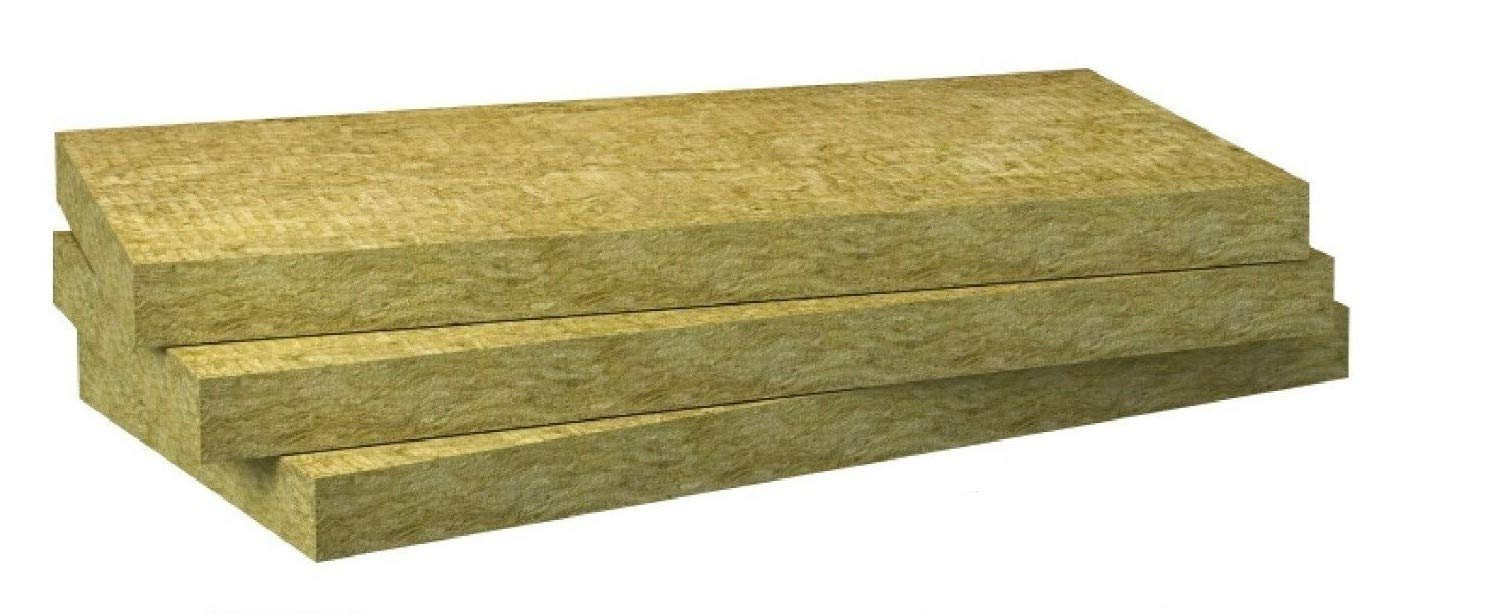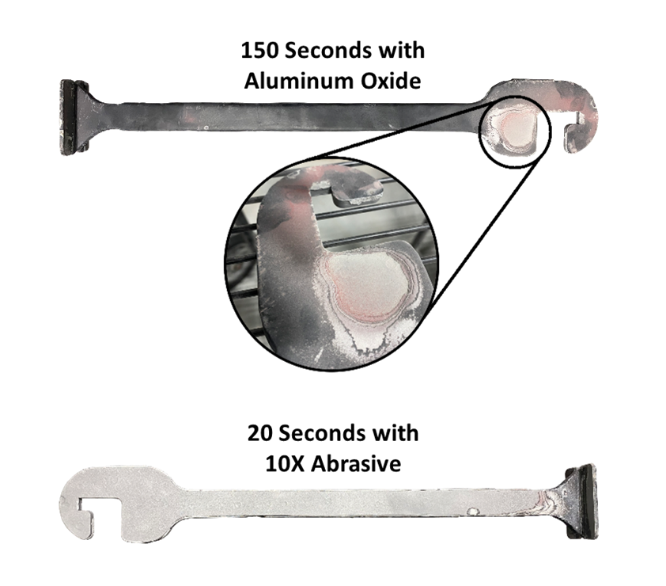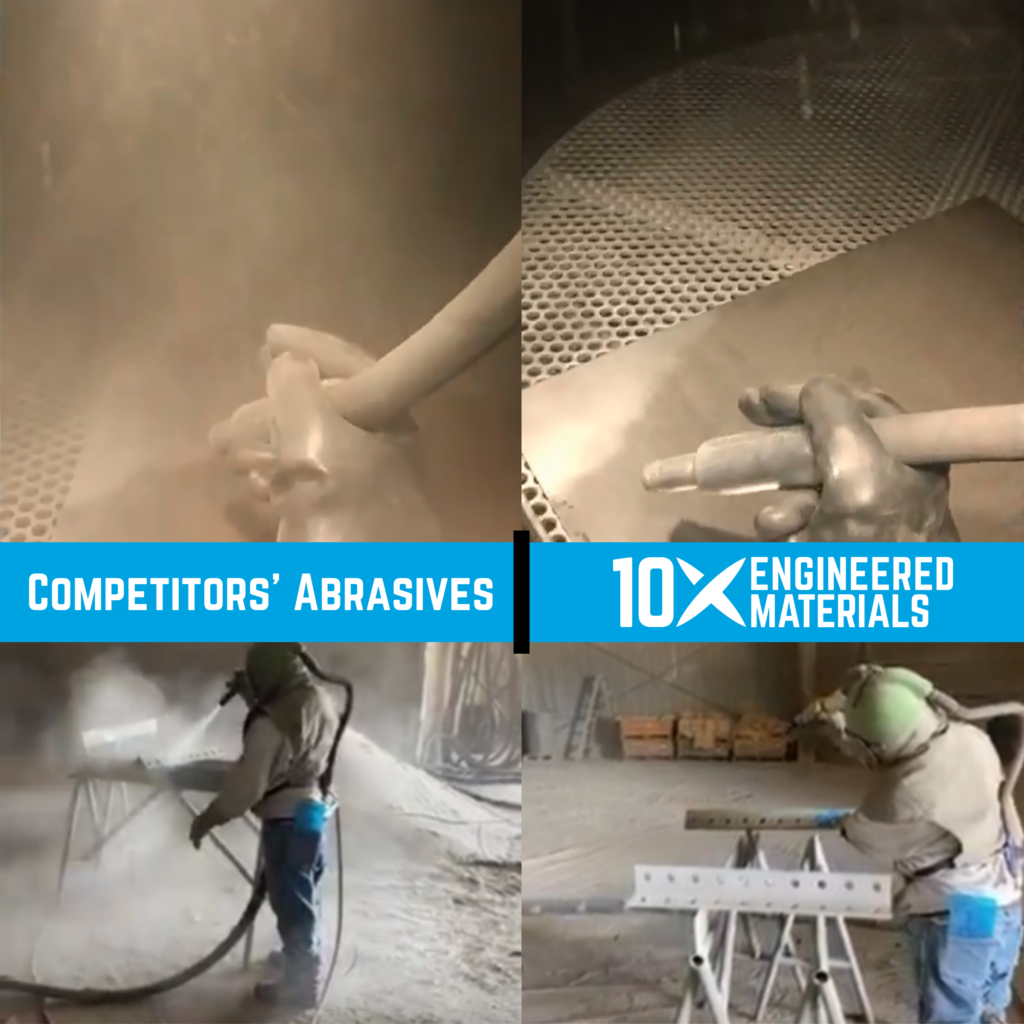10X Vs. Aluminum Oxide
Aluminum Oxide
Aluminum Oxide has been manufactured and used since the mid-1800s, first as naturally occurring mineral blends that included corundum (aluminum oxide). In the early-to-mid 1900’s, electric arc reduction furnaces began to be used to manufacture fused granular aluminum oxide materials formed from bauxite ore. Similar processes are still used to make aluminum oxide blasting abrasives today.
Aluminum oxide grains have a relatively high material density of 3.9 g/cm3 and a Mohs hardness of 9.0. Most aluminum oxide blasting products consist of 96-99% aluminum oxide with the balance including titanium dioxide, silicon dioxide, iron oxide, and trace levels of other mineral oxides. Aluminum oxide is also a largely crystalline or semi-crystalline material, which means that the atoms and molecules in the material are arranged in an ordered structure and that individual grains are likely to have relatively sharp edges, also known as angularity in the abrasives industry.
The sharpness, or angularity, of aluminum oxide offers advantages in aggressiveness and coating removal and disadvantages in the higher rate at which consumable parts like fittings, hoses, and nozzles wear out. Its hardness makes the abrasive durable in bonded abrasive applications and reusable in granular applications like abrasive blasting. The crystallinity of aluminum oxide can account for some of its durability, but defects within and between crystal domains in an abrasive grain can cause particle fracture and excessive dust formation in abrasive blasting.
Because of its long history in the granular materials markets, aluminum oxide abrasive is produced in a wide range of particle sizes and is used in diverse applications. All particle size grades are used in both bonded abrasives and granular sediment abrasive applications. Coarser grades are used as fillers, in grinding wheels, in sandpaper, and in abrasive blasting to remove heavy corrosion and surface coatings to prepare the surfaces for recoating and reuse. Finer grades are used in polishing, surface etching, deburring, precision grinding, and abrasive blasting when smoother, lower-profile surface finishes are required.
10X Superoxalloy Abrasives
Overview of Superoxalloy Technology
10X superoxalloy abrasives are an alloy of oxide minerals created through highly controlled formulation and tempering (high heat + rapid cooling) as a byproduct of mineral wool insulation manufacturing. This patented technology is a new discovery in abrasives that is creating disruptive positive change in the surface-preparation industry. It has now been adopted and is in use in shipping, rail, oil & gas, fabrication, powder coating, and many other applications. 10X superoxalloy abrasives are displacing both inexpensive consumable slag abrasives, as well as harder and more reusable abrasives, including garnet, aluminum oxide, and silicon carbide.
10X Superoxalloy abrasives are comprised of extra strong, tempered, non-crystalline (amorphous) particles that resist breaking under the stress of high-speed mechanical impact. The abrasives are produced in a controlled manufacturing environment using a sustainable process and are not subject to the variations in composition and performance that often arise with legacy mineral abrasives that are mined from the Earth or formed in uncontrolled environments. Abrasives that are formed in an uncontrolled environment will contain unavoidable pores and mineral solid domains that are held together along weakly bound planes (cleavage planes). These pores and cleavage planes decrease the impact strength of the particles and inhibit the efficiency of the abrasive in performing productive work on a surface.
Figure 1. The amorphous (isotropic) particle morphology of superoxalloy abrasives results in high impact strength because they are tempered and do not contain the pores and cleavage planes that are common in mineral abrasives formed in an uncontrolled environment.
Entirely New Benefits in Surface Preparation
The impact strength of superoxalloy particles offers an entirely new set of benefits in mineral abrasives in ways that at first appear counterintuitive. There is no loss of performance from the presence of both rounded and sub-rounded particles in addition to angular particles. There is in fact a significant and measurable increase in productivity, efficiency, surface quality, and coating performance. Superoxalloy particles contain a fair fraction of rounded particles and a Mohs hardness of around 7, yet regularly outperform harder and sharper abrasives, including garnet, aluminum oxide, and even silicon carbide. This is especially true in the most difficult applications like the removal of hardened powder coat, ship claddings, thick ceramics, or elastomeric coatings where mechanical scraping, chemical treatment, or thermal burn-off are often required to make abrasive blasting possible.
Particle strength, rather than hardness or sharpness, enables superoxalloy particles to quickly remove nearly impossible coatings without the need for auxiliary preparation steps. Particle strength and the presence of rounded and sub-rounded particles also enable a bright and clean surface finish, free of embedded residues, that improve surface quality, coating performance, and the service life of assets being manufactured or refurbished.
Higher Speed and Lower Consumption from Efficient Delivery of Particle Energy
Abrasive blasting is essentially an energy transfer process. Air compressors, pressure pots, metering valves, hoses, and nozzles are used to accelerate abrasive particles to very high speed (energy) with the objective of delivering that particle energy as efficiently as possible to perform work on a surface. When particles break on impact with a surface, no matter how hard or sharp they are, much of the energy of the particles is expended in the process of breaking, which results in lower energy delivery to the surface where it is needed. Because fewer superoxalloy particles break on impact, they deliver virtually all the energy they have to the surface. This enhanced energy delivery increases blasting speed by 20-50% compared with sharper and harder abrasives like garnet and aluminum oxide while also decreasing abrasive consumption by at least 20% and as much as 85% because fewer particles are needed to do the required work per square foot of surface.
Figure 2. 10X enables rapid blasting of powder coated hangar hooks that aluminum oxide could not remove.
Maximum Use of Available Air Pressure
The performance of mineral abrasives tends to increase with nozzle pressure and then level off, or even decrease, when the pressure is raised above certain thresholds, which are typically around 105-110 psi. The excessive impact forces at higher pressure cause the particles to pulverize into dust, substantially decreasing their effectiveness. With superoxalloy abrasives, the pressure at the nozzle can be raised to 120 psi or higher and the performance of the abrasive continues to improve. The particles can withstand the impact forces, continue to bounce off the surface without breaking or embedding, and deliver the extra energy that they possess by virtue of the higher nozzle pressure. Superoxalloy abrasives can be reused multiple times if there is reclaim equipment available.


Figure 3. Performance comparison of 10X and copper slag on a heavily rusted tank at 120 psi. 50 lb of copper slag completed less than 25% of the tank. 50 lb of 10X KinetiX-20/70 finished the remainder of the tank with abrasive left over. 10X increased speed by 50% and decreased consumption (lb/ft2) by 86%.
Enhanced Surface Quality, Coating & Bonding Performance
Metal coatings and bonding agents are formulated to uniformly cover and bond with substrate metal. Coating specifications set forth requirements for preparing the surface to be coated, which include the desired profile depth and surface cleanliness. Particles that pulverize on impact with a surface tend to smear and embed into the surface profile, much like mud sticking to a wall. These embedded residues prevent coatings from bonding to the metal as they were formulated to do, which can result in poor adhesion, telegraphing, delamination, and premature failure of the coating. Superoxalloy particles bounce off the surface, leaving ultra-clean metal for maximum coating adhesion without the need for subsequent chemical cleaning.

Figure 4. 10X abrasives outperformed silicon carbide on braze-bonded asphalt milling bits. 10X abrasives decreased blasting time by 67%, eliminated flux cleaning of bond surfaces, and achieved a 125% increase in bond strength.
Delayed Rust Bloom
Among the cost and scheduling challenges in blast and paint operations is the rapid onset of rust bloom on a blasted surface before coating, particularly in marine and other humid environments. Rust bloom is a common cause of poor coating adhesion and premature coating failure. Many applications require the use of corrosion inhibitors or dehumidifiers to afford enough transition time between blasting and application of the first coating layer without having to re-blast the surface.
Rust bloom forms quickly when water-soluble salts or iron residues are left behind in embedded material on a steel surface after abrasive blasting. These residues accelerate the electrochemical reactions in which iron in the steel is oxidized to form iron oxide on the surface. Without these residues, the bare metal would corrode at a naturally slower rate, allowing ample time between surface preparation and coating before the corrosion layer develops. The impact strength and unique particle shape distribution of superoxalloy particles prevents embedment and leaves an ultra-clean surface free of corrosion-promoting residues. The surface is not only clean after blasting, but it stays clean and free of rust bloom for as long as weeks without the need for corrosion inhibitors, even in the most humid environments or rainy weather.

Figure 5: Test panel blasted with 10X abrasive, garnet, and copper slag in Houston, TX. Significant rusting on sections blasted with garnet and copper slag after two days in the rain. No sign of rust formation on surfaces blasted with 10X abrasives.

Figure 6. Ship hull blasted to an SSPC SP6 finish in a Pacific Northwest shipyard held for two weeks without evidence of rust bloom.
Low Dust and Improved Visibility
Because of their impact strength, superoxalloy particles bounce off surfaces rather than pulverize into dust, unlike just about every other mineral abrasive. The time-averaged total dust concentration is therefore much lower and the visibility, productivity, and safety for workers is greatly improved. Users of superoxalloy regularly comment on the enhanced visibility during blasting, especially in enclosed spaces.
Figure 7. 10X abrasives produce very little dust in both cabinet and field blasting applications, particularly when compared to legacy mineral abrasives (staurolite, garnet, aluminum oxide, and slags).
The Only Abrasive Material Stamped by Global Authorities to be Safe for Human Use
Human epidemiological and animal exposure studies by private and government research organizations provide the foundational dose-response data that shows whether, and at what dose, a substance becomes toxic. Determinations about toxicity and carcinogenicity are made from these studies by authoritative review organizations like the International Agency for Research on Cancer (IARC), the U.S. National Toxicology Program (NTP), and the American Conference of Governmental Industrial Hygienists (ACGIH). Regulating bodies including EPA, OSHA, and OSHA counterparts worldwide use the conclusions of the review organizations to set rules and exposure limits.
10X superoxalloy abrasives are 100% recycled from a byproduct of mineral wool manufacturing. Mineral wool is a fibrous material that has been safely used for 100 years as insulation, fireproofing, sound-proofing, and hydroponic food crop growing media. It is also among the most toxicologically studied commercial materials in history. Tens of millions of dollars were invested in human and animal studies to determine whether mineral wool dust is hazardous or carcinogenic. Superoxalloy abrasives and mineral wool have identical properties and material composition.

Figure 8: Mineral wool insulation fiber board.
Because it has the same composition and properties of mineral wool, 10X superoxalloy is the only abrasive material with hundreds of studies that justify an official IARC determination about its safety and carcinogenicity. IARC convened a working group of experts from around the world in 2001 to review this massive body of research. In their 2002 IARC Monograph, Volume 81, the IARC experts unanimously concluded that mineral wool is not classifiable as carcinogenic in humans (Group 3):
- Lack of evidence of excess illness or mortality in decades of human epidemiological studies following 26,000 exposed workers in the U.S. and Europe starting in the 1930s,
- Lack of lung damage, cancer, or decreased lifespan in animal studies of exposure to high dust concentrations over 80% of the animals’ lives,
- Because of its chemical composition, the material is biosoluble in the lungs and is cleared with no permanent chronic effects.

Figure 9. Cover of the International Agency for Research on Cancer monograph that removed mineral wool material from lists of possible human carcinogens worldwide.
Superoxalloy abrasives are comprised of the same material in a particle form that is even more readily cleared from the lungs than mineral wool fiber. This IARC decision removed mineral wool from lists of carcinogens everywhere in the world. Every mineral wool manufacturer in the world took these learnings to heart and now formulates their products to be biosoluble in the lungs. No regulating body in the world considers the material to be any more hazardous than nuisance dust. If you happen to be exposed to superoxalloy abrasive dust, you can rest assured that your lungs can handle it the same way that they handle the millions of dust particles that we inhale in each of the 17,000+ breaths we take every day.



